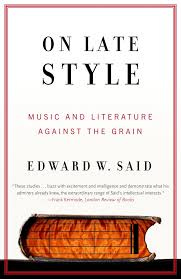Glenn Gould's eminence
Reading: On Late Style: Music and Literature Against the Grain (2006) by Edward Said
[….] [Gould] could never have attained his degree of eminence had he not had the services of Columbia Records and the Steinway piano corporation at his disposal at crucial moments in his career, to say nothing of the telephone company, concert house managers, intelligent recording producers and engineers, and medical networks he worked with all of his adult life. But he also had a phenomenal gift that functioned brilliantly in that environment and yet moved beyond it at the same time.
There isn’t much point in going over the characteristics that made Gould the extraordinary eccentric that he was: the low bench, the humming, gesticulating, untoward grimacing and conducting he indulged in as he played, the strange liberties he took with composers like Mozart whom he disliked, and indeed, the odd choice of repertory that would include the Bach that he made uniquely his plus composers—like Bizet, Wagner, Sibelius, Webern, and Richard Strauss—not widely known for using the keyboard as their chosen medium. But there is no way of getting past the fact that from the moment Gould’s recording of the Goldberg Variations became available, a genuinely new stage in the history of virtuosity was attained: he lifted the sheer mastery of playing before the public to an elevation, or call it a side road or deviation, of an unprecedented kind. What made his appearance more pronounced as a sort of original event was that he had no known precedents in the history of music (Busoni comes to mind, but as soon as one saw or heard Gould at work, the comparison with the Italian-German thinker and pianist would quickly and rightly be dismissed), belonged to no dynasty of teachers or national schools, and played repertory (for example, Byrd, Sweelinck, and Gibbons) that had never been thought of before as furnishing staples on a piano recital program. Add to all of this Gould’s remarkably fleet, rhythmically tense, and challenging method of playing well-known pieces, plus his core attachment to the fugue and chaconne forms that are perfectly embodied in the sarabande aria and thirty variations of the Goldberg Variations, and initially at least you have a totally unanticipated talent aggressing against the customarily placid and passive audience that has been routinized into the practice of sitting back and simply waiting to be served up a short evening’s fare—diners at an evening’s service in a good restaurant. A few measures of Gould’s 1957 recording of the Beethoven Third Concerto with Karajan, or a scene or two from his video performances of fugue, tell us immediately that something besides concert virtuosity is being attempted here. It should be added that Gould’s basic pianistic capacities were indeed quite awesome, certainly on a par with Horowitz’s, who seems to have been the one pianist Gould considered his overrated rival. When it came to rapidity and clarity of execution; a phenomenal gift for double thirds, octaves, sixths, and chromatic sequences; a magnificently sculpted portamento that made the piano being played sound like a harpsichord; a unique power for sheer transparency of line in contrapuntal textures; an unparalleled ability to sight-read, memorize, and play complex contemporary, classical orchestral, and operatic scores on the piano (see, for instance, his renderings of Strauss operas, voice parts and all), Gould stood very very high indeed and was easily on a technical level with artists like Michelan-geli, Horowitz, Barenboim, Pollini, and Argerich. So one could listen to Gould and get some of the same pleasures afforded by the old-fashioned or modern virtuoso, even though my point is that there was always something more that he did that made him so thoroughly unu
On Late Style: Music and Literature Against the Grain (2006) by Edward Said



